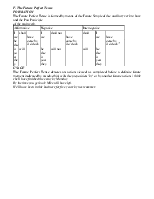












A. The Present Simple (Indefinite) Tense
FORMATION
|
Affirmative |
Negative |
Interrogative |
|||||
|
1 you |
work go |
I you |
do not |
work go |
do |
I you |
work? go? |
|
he she it |
works goes |
he she it |
does not |
does |
he she it |
||
|
we you they |
work |
we you they |
do not |
do |
we you they |
||
Contractions:
don't = do not doesn't = does not
I work - he works; you play - she plays;
we finish - it finishes; I cry - she cries The ending -s/-es has three variants of pronunciation: [s], [z], [iz].
|
[s] |
Iz] |
[iz] |
|
after voiceless |
after voiced consonants |
after |
|
consonants |
and vowels |
|
|
puts |
reads |
changes |
|
writes |
buys |
dresses |
|
sits |
gives |
marches |
In interrogative and negative sentences the Present Simple tense takes the auxiliary do or does (for the 3rd person singular) with the exception of the verb to be which does not need an auxiliary.
When does he usually do his homework?
What do you do for a living?
I don't feel like going out tonight.
Why are you so angry with him?
He is not in. He is out.
USAGE
The Present Simple (Indefinite) tense denotes:
1. Habitual facts or repeated actions, which are normally indicated by adverbials of frequency such as often, always, usually, seldom, rarely, sometimes, never, generally, as a rule, every day (month), every other day (week, month, etc.,), once a week, etc.
He often works till midnight.
My brother plays tennis every other day.
Are you never late for classes?
Do you generally speak English in class?
2. Universal truths (laws of nature) and permanent characteristics, situations or states.
The sun sets in the west. She teaches English at school. Do you like rainy weather? His parents live in London.
3. Present actions and states, going on at the moment of speech with the so-called stative* verbs which include
a) verbs of sense perception: see, hear, notice, taste, smell, etc.
It smells like a hospital in here.
The meat tastes spicy.
I don't see anyone in the room. Where are they all?
b) verbs of mental activity: understand, think, believe, remember, know, forget, mean, suppose, recognize, etc.
Do you recognize me? What does he mean?
Who do you think will win the game? Do you know what he is speaking about?
c) verbs of feeling and emotions: like, dislike, hate, love, wish, want, prefer, care, etc.
I prefer dogs to cats.
Which of these dresses do you like best?
About the possibility of using the Present Continuous with some of the stative verbs see Part B of this Unit.
Do you want anything to drink? - I want a glass of juice, please.
Jill really hates house work.
d) verbs of possession: have, belong, own, possess, etc. Who does this car belong to? They have a big new house.
4. Future actions
a) in subordinate clauses of time and condition after the conjunctions when, after, before, as soon as, until, if, in case, etc.
When the water boils I'll turn off the gas. I'll join you as soon as I get a note from you. You won't get slim if you eat too many sweets. I'll tell you a secret if you promise to keep it. b) for scheduled facts and events such as flights, train arrivals, departures, itineraries which are worked out officially and are certain to take place.
The flight leaves at 2 p.m. (according to the timetable)
You arrive at Basel at 6.30 a.m. local time, (according to the itinerary)
B. The Present Continuous (Progressive) Tense
FORMATION
The Present Continuous tense is formed with the help of the auxiliary be in the appropriate form and the Present Participle of the main verb.
|
Affirmative |
Negative |
Interrogative |
||||||
|
I |
am |
working |
I |
am not |
working |
am |
I |
working? |
|
YOU |
are |
you |
are not |
are |
you |
|||
|
he she it |
is |
he she it |
is not |
is |
he she it |
|||
|
we you they |
are |
we you they |
are not |
are |
we you they |
|||
Contractions:
'm = am 're = are 's = is
aren't = are not isn't = is not
When -ing is added to a verb there may be some changes in spelling:
a) final e is omitted: have - having; make - making;
b) ie is replaced by y: lie - lying; die - dying;
Уважаемый посетитель!
Чтобы распечатать файл, скачайте его (в формате Word).
Ссылка на скачивание - внизу страницы.